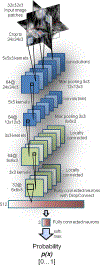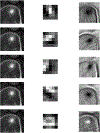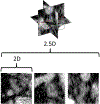Improving Computer-Aided Detection Using Convolutional Neural Networks and Random View Aggregation
- PMID: 26441412
- PMCID: PMC7340334
- DOI: 10.1109/TMI.2015.2482920
Improving Computer-Aided Detection Using Convolutional Neural Networks and Random View Aggregation
Abstract
Automated computer-aided detection (CADe) has been an important tool in clinical practice and research. State-of-the-art methods often show high sensitivities at the cost of high false-positives (FP) per patient rates. We design a two-tiered coarse-to-fine cascade framework that first operates a candidate generation system at sensitivities ∼ 100% of but at high FP levels. By leveraging existing CADe systems, coordinates of regions or volumes of interest (ROI or VOI) are generated and function as input for a second tier, which is our focus in this study. In this second stage, we generate 2D (two-dimensional) or 2.5D views via sampling through scale transformations, random translations and rotations. These random views are used to train deep convolutional neural network (ConvNet) classifiers. In testing, the ConvNets assign class (e.g., lesion, pathology) probabilities for a new set of random views that are then averaged to compute a final per-candidate classification probability. This second tier behaves as a highly selective process to reject difficult false positives while preserving high sensitivities. The methods are evaluated on three data sets: 59 patients for sclerotic metastasis detection, 176 patients for lymph node detection, and 1,186 patients for colonic polyp detection. Experimental results show the ability of ConvNets to generalize well to different medical imaging CADe applications and scale elegantly to various data sets. Our proposed methods improve performance markedly in all cases. Sensitivities improved from 57% to 70%, 43% to 77%, and 58% to 75% at 3 FPs per patient for sclerotic metastases, lymph nodes and colonic polyps, respectively.
Figures















Similar articles
-
A new 2.5D representation for lymph node detection using random sets of deep convolutional neural network observations.Med Image Comput Comput Assist Interv. 2014;17(Pt 1):520-7. doi: 10.1007/978-3-319-10404-1_65. Med Image Comput Comput Assist Interv. 2014. PMID: 25333158 Free PMC article.
-
Massive-training support vector regression and Gaussian process for false-positive reduction in computer-aided detection of polyps in CT colonography.Med Phys. 2011 Apr;38(4):1888-902. doi: 10.1118/1.3562898. Med Phys. 2011. PMID: 21626922 Free PMC article.
-
CT colonography: advanced computer-aided detection scheme utilizing MTANNs for detection of "missed" polyps in a multicenter clinical trial.Med Phys. 2010 Jan;37(1):12-21. doi: 10.1118/1.3263615. Med Phys. 2010. PMID: 20175461 Free PMC article.
-
Lymph node detection in CT scans using modified U-Net with residual learning and 3D deep network.Int J Comput Assist Radiol Surg. 2023 Apr;18(4):723-732. doi: 10.1007/s11548-022-02822-w. Epub 2023 Jan 11. Int J Comput Assist Radiol Surg. 2023. PMID: 36630071
-
Automatic detection of lytic and blastic thoracolumbar spine metastases on computed tomography.Eur Radiol. 2013 Jul;23(7):1862-70. doi: 10.1007/s00330-013-2774-5. Epub 2013 Feb 9. Eur Radiol. 2013. PMID: 23397381 Free PMC article.
Cited by
-
Towards automated organs at risk and target volumes contouring: Defining precision radiation therapy in the modern era.J Natl Cancer Cent. 2022 Oct 11;2(4):306-313. doi: 10.1016/j.jncc.2022.09.003. eCollection 2022 Dec. J Natl Cancer Cent. 2022. PMID: 39036546 Free PMC article. Review.
-
DeepLesion: automated mining of large-scale lesion annotations and universal lesion detection with deep learning.J Med Imaging (Bellingham). 2018 Jul;5(3):036501. doi: 10.1117/1.JMI.5.3.036501. Epub 2018 Jul 20. J Med Imaging (Bellingham). 2018. PMID: 30035154 Free PMC article.
-
Bi-stream CNN Down Syndrome screening model based on genotyping array.BMC Med Genomics. 2018 Nov 20;11(Suppl 5):105. doi: 10.1186/s12920-018-0416-0. BMC Med Genomics. 2018. PMID: 30453947 Free PMC article.
-
Real-time artificial intelligence (AI)-aided endoscopy improves adenoma detection rates even in experienced endoscopists: a cohort study in Singapore.Surg Endosc. 2023 Jan;37(1):165-171. doi: 10.1007/s00464-022-09470-w. Epub 2022 Jul 26. Surg Endosc. 2023. PMID: 35882667 Free PMC article.
-
A review of deep learning in medical imaging: Imaging traits, technology trends, case studies with progress highlights, and future promises.Proc IEEE Inst Electr Electron Eng. 2021 May;109(5):820-838. doi: 10.1109/JPROC.2021.3054390. Epub 2021 Feb 26. Proc IEEE Inst Electr Electron Eng. 2021. PMID: 37786449 Free PMC article.
References
-
- W. H. Organization, Cancer Fact shee N297. WHO, 2014.
-
- Msaouel P, Pissimissis N, Halapas A, and Koutsilieris M, “Mechanisms of bone metastasis in prostate cancer: clinical implications,” Best Practice & Research Clinical Endocrinology & Metabolism, vol. 22, no. 2, pp. 341–355, 2008. - PubMed
-
- Wiese T, Yao J, Burns JE, and Summers RM, “Detection of sclerotic bone metastases in the spine using watershed algorithm and graph cut,” in SPIE Med. Imag, pp. 831512–831512, 2012.
MeSH terms
Grants and funding
LinkOut - more resources
Full Text Sources
Other Literature Sources
Miscellaneous

